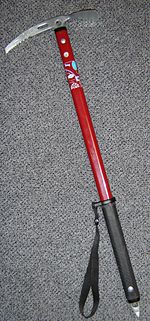ice pick


The ice ax is an item of equipment in alpinism at full speed . It serves the climber as Gehunterstützung on rock, snow, corn snow and ice, to probe the snow cover on crevasses , for climbing on ice , for braking a fall on inclined snow or Firnflächen by pimples rescue handle, as anchor for securing of cable partners and for salvaging fallen into crevasses. Before the introduction of the crampons with front points (from 1932) it was also used to hit steps in the ice (similar to a pickaxe ); In this role, the ice ax is only used today when crampons are not available.
origin
Emerged the ice ax with the development of the guide being in the Alps from a cleaver and the Alpenstock . He had an ax head with pick and shovel made of steel and a wooden shaft with steel tip. The Swiss mountain guide Franz Josef Lochmatter brought the first ice ax that was used in Chamonix to the Mattertal and Switzerland around 1860 .
This predecessor of the modern ice ax is still called the "Aschenbrenner ice ax" after its designer, mountaineer Peter Aschenbrenner . In modern ice axes, the shaft is made of aluminum , the pick and shovel are made of alloyed steels (e.g. chrome - molybdenum or nickel- chrome-molybdenum).
Manufacturing
Ice axes are very rarely forged by hand . A piece of engineering steel (0.53% carbon , 0.95% silicon , 1% manganese ) is pre-pressed in a die and then forged into a blank in several stages. This in turn is ground and polished to a high gloss, which among other things results in better corrosion resistance . Modern ice axes are largely drop forged . In this process, soft-annealed steel is preformed at a temperature of around 850 ° C and pressed into the die. As a result, the grain is not interrupted, but only aligned, which results in increased strength.
use
Depending on the intended use, a distinction is made between ice axes for light or medium high-altitude tours and special ice axes for combined tours or for ice climbing. They are available in different shaft lengths from 40 to 90 cm, whereby it is assumed that pimples with a length of 60 to 70 cm are sufficient for glacier visits.
Normalization
There are two standards for ice ax and ice ax , which differ in terms of the corresponding tests. A distinction is made between “B” devices (basic devices) and “T” devices (technical devices). The latter are intended for more extreme use and are subject to higher requirements.
Ice ax as a murder instrument
Russian revolutionary leader Leon Trotsky was attacked with an ice ax in 1940 and died of the injury. In 2005 the ice ax, believed to be lost, was found. The murder instrument was exhibited in the Criminological Museum in Mexico City, but was then replaced by a copy because of the risk of theft. A Mexican secret service agent, also a co-founder of the museum, took the original ax and kept it, wrote the Mexican daily La Jornada. His daughter reported that her father tried four times to no avail to return the ice ax. But nobody wanted the original back. Then this daughter took the ice ax and presented it on a radio broadcast.
In literature and film emerge as a murder weapon usually more (cash) ice pick ( Engl. Ice pick ), which among other things for crushing Blockice serve. They're smaller than the mountaineering ice ax and come in a variety of shapes, including simple handle-grip thorns that can also be used as a stabbing weapon.
Web links
swell
- ↑ How to carry the pimple: Jost Gudelius at http://www.gudelius.de/pickel.htm .
- ↑ Christian Imboden: Mountains: Profession, Vocation, Fate . Rotten Verlag , Visp 2013, ISBN 3-907624-48-3 . Pages 75 f .: Promoters of mountain hut construction and the use of mountain picks
- ↑ Grivel: History of the ice ax (English) .
- ^ Don Graydon: Perfect Mountaineering - The High School of Alpinism (German version by Thomas Küpper), Pietsch Verlag, Stuttgart 1997, ISBN 3-613-50276-3 .
- ↑ Standard testing of ice axes and ice tools (PDF; 2.5 MB).
- ↑ Trotsky murder weapon 'in Mexico' , BBC News (English)

